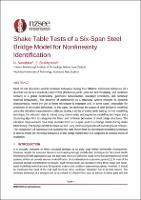| dc.description.abstract | Most of real structures exhibit nonlinear behaviour during their lifetime. Nonlinear behaviour of a structure can be as a result of a local effect (friction in joints, joint and link flexibility, and nonlinear contact) or a global nonlinearity (geometric nonlinearities, boundary conditions, and nonlinear material behaviours). The presence of nonlinearity in a structural system changes its dynamic characteristics, hence the use of linear techniques is improper and, in some cases, impossible for prediction of the system behaviour. In this paper, the nonlinear behaviour of steel bridges is modelled using the vibration measurements collected during a series of shake table testing. In this modelling technique, the vibration data is trained using a time series autoregressive modelling technique and a clustering algorithm to categorise the linear and nonlinear behaviour of steel bridge structures. The vibration measurements have been recorded from a six-span steel truss bridge model during shake table testing. The bridge model has been excited using various amplitudes of several ground motions. The comparison of numerical and experimental data shows that the developed modelling technique is able to model the nonlinear behaviour of the bridge model once it is subjected to various levels of excitation. | |

